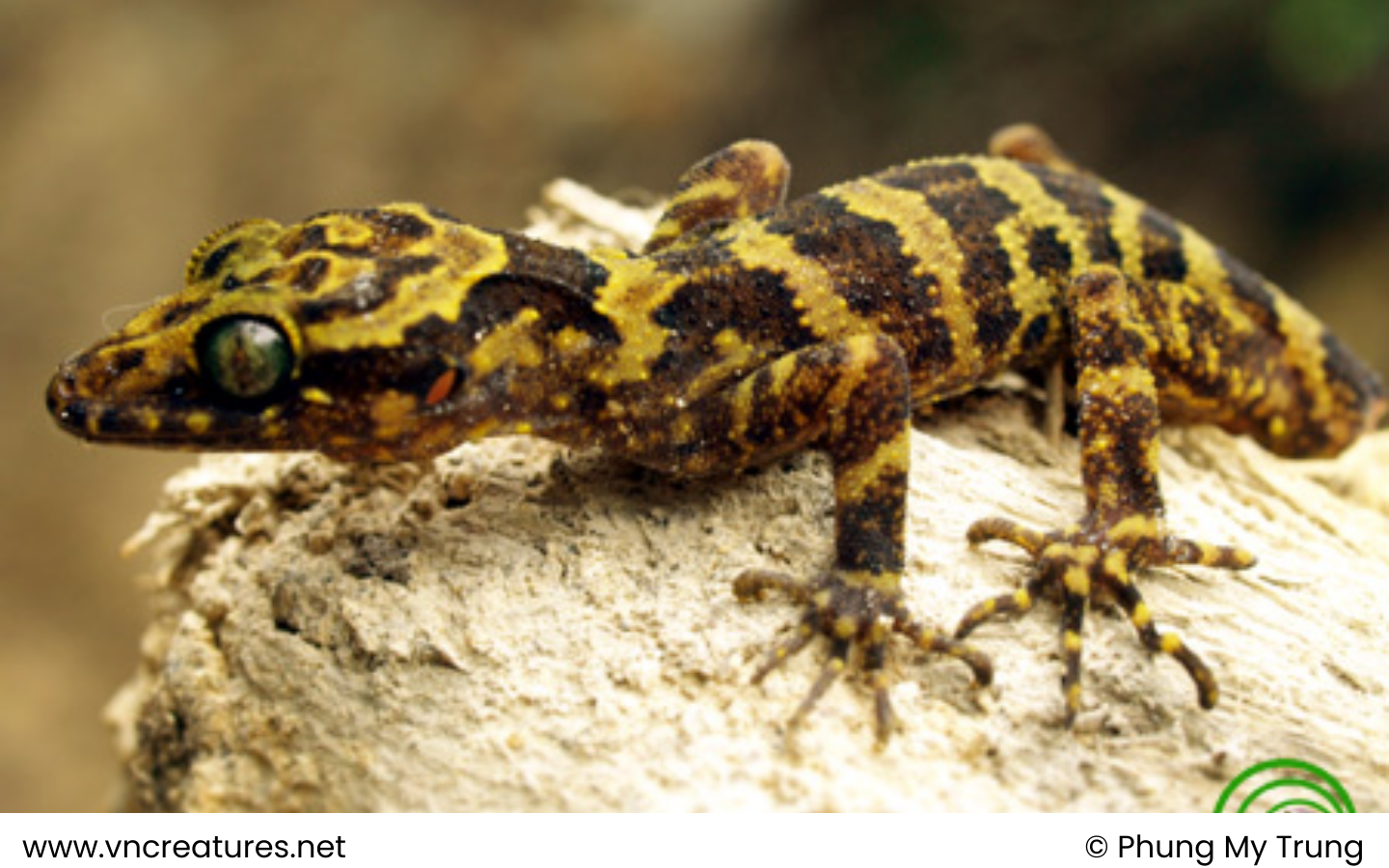
Science name: Cyrtodactylus ziegleri – Nazarov, Orlov, Nguyen & Ho, 2008
Taxonomic: Animalia>> Chordata>> Reptilia>> Squamata >> Gekkonidae >> ziegleri
Species status: Endemic ; IUCN status: LC (Least Concern)
Description:
Physical Characteristics:
Cyrtodactylus ziegleri is a large gecko, with a snout-vent length (SVL) ranging from 84.6 to 93 mm. Its body is slender, with moderately long limbs and digits. The tail is original, not thick, and longer than the body. The dorsal surface has 20–24 rows of enlarged, weakly keeled tubercles, while the ventral surface has 33–39 scales between ventrolateral folds. Males typically have 5–8 preanal pores arranged in a single A-shaped series, and there are 8–10 enlarged femoral scales on each side.
Coloration and Appearance:
The dorsal coloration varies from light yellowish to light brown, with 4–6 dark brown transverse bands between the limbs. These bands lack contrasting white borders, and a V-shaped occipital dark band is often present. The tail exhibits 8–11 dark transverse bands, with irregular edges.
Distribution and habitat:
Elevation: Found at elevations ranging from 500 to 2,000 meters above sea level.
Area: Cyrtodactylus ziegleri is native to Vietnam, specifically known from Chu Yang Sin National Park in Krong Bong District, located in the southern part of Dac Lac Province. While it has only been officially recorded within the park, it is likely that the species has a broader range in adjacent areas.
Habitat: This species inhabits subtropical/tropical moist lowland forests and can be found in primary, secondary, and degraded forests. It has been observed on tree trunks and rocky outcrops near streams, reflecting its ability to adapt to various forest environments.
Behaviour and ecology:
Lifestyle:
Cyrtodactylus ziegleri is primarily found on tree trunks and rocky outcrops near streams in forested areas. It is adapted to a variety of forest types, including degraded forests, and is observed at higher elevations, up to around 2,000 meters.
Reproduction:
The species is oviparous, with females laying eggs during the breeding season. The eggs are likely laid in sheltered locations such as rock crevices or under vegetation.
Diet:
Like other geckos, Cyrtodactylus ziegleri likely feeds on small invertebrates found in its forest habitat.
Conservation and status:
IUCN Red List Category and Criteria:
Cyrtodactylus ziegleri is listed as Least Concern (LC) due to its stable population and the lack of significant threats within Chu Yang Sin National Park, where it is primarily found.
Threats:
Currently, there are no major threats to the species, as it resides in a protected area with a stable environment.
Conservation Actions:
Ongoing protection of Chu Yang Sin National Park is crucial for maintaining the species’ habitat. Further research is recommended to determine whether populations exist outside the park and to monitor the species’ long-term stability.
Crocodile Trail – The Best Birding Trail in Cat Tien National Park
If you’re a birder or nature photographer planning a trip to Vietnam, few places offer [...]
Cong Troi Trail – Top 1 Dalat Plateau Birding Trail Experience
If you’re a birder or nature photographer planning a trip to Vietnam’s Central Highlands, the [...]
How to Identify the Greater Sand Plover, Tibetan Sand Plover and Siberian Sand Plover
Identification Differences within the Sand Plover Complex: The sand plover group, which was traditionally divided [...]
Highlights of Cat Tien National Park Reptiles and Amphibian Endemics
Spanning over 71,350 hectares of tropical forests, grasslands, and wetlands, Cat Tien National Park is [...]
Highlights of Cat Tien National Park Mammals in a World Biosphere Reserve
In addition to reptiles and birds, Cat Tien National Park is also rich in mammals, [...]
Kontum Plateau Endemic and Highlight bird
Kontum Plateau Endemic And Highlight Bird species like Chestnut-eared Laughingthrush and top birding routes while [...]